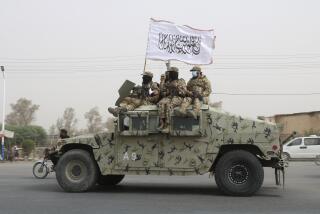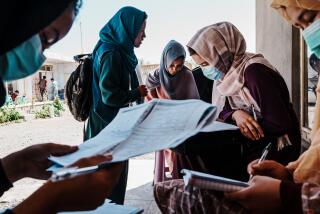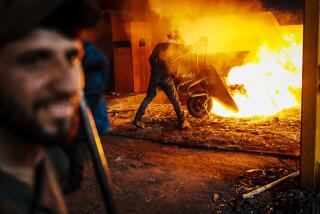A once-tranquil corner of Afghanistan turns deadly
KABUL, Afghanistan — Not long ago, Bamiyan province was considered one of the most peaceful corners of Afghanistan, a remote and scenic enclave that was largely free of the daily violence that roils so much of the country. Now it may become a cautionary tale about the pitfalls of winding down the war here.
In the summer of 2011, Bamiyan’s tranquil image was such that it was picked as the country’s first province for the transfer of fighting duties from Western forces to Afghan troops, a process that is to be replicated across Afghanistan in a prelude to the end of NATO’s combat role in 2014.
In recent months, however, a province best known as the site of the giant Buddhas that were dynamited more than a decade ago by the Taliban has been making news of the most ominous kind, including the deaths of five soldiers from New Zealand this month. To put that loss in perspective, the fatalities represented half of that nation’s battle deaths for the entire war, including its first woman killed in conflict since 1966.
Even before the recent spasm of violence, there had been other danger signs for Bamiyan: the deaths of nine Afghan policemen in two bombing attacks in July, and the abduction and decapitation last year of Bamiyan’s popular provincial council leader as he traveled to the capital, Kabul.
At the war’s outset, Bamiyan seemed better positioned than almost any part of Afghanistan to fend off an insurgent presence. Tucked away in the central highlands, its population is mainly made up of ethnic Hazaras, whose fierce anti-Taliban sentiments were stoked by the systematic massacre of thousands during the fundamentalist movement’s reign over Afghanistan in the 1990s.
Isolated by punishing winters and a poor road network, Bamiyan was never an insurgent thoroughfare, unlike conflict zones in the country’s south and east that are crisscrossed by fighters with the Taliban, Pakistan’s Haqqani network and other militant groups. And the haunting emptiness of the Buddha niches is a daily reminder of the fruits of Taliban intolerance.
Although the province is formally at the forefront of the nationwide “transition” effort, critics complain that the handoff of responsibility to Afghan forces has been fraught with problems.
“At the time of the hand-over ceremony, the transitional authority promised to increase the number of police, and give them better training and equipment, but these promises did not materialize,” said Mohammad Akbari, a lawmaker from Bamiyan. “There are no Afghan soldiers, and the number of police is not more than 1,000 for the entire province.... If there are no remedial measures, there are fears that security will get even worse.”
Perhaps because of deteriorating safety, Bamiyan’s “transition” has not yet been declared complete, a step that NATO officials had signaled this year was imminent. No date has been set.
Local people are also anxiously wondering how Bamiyan will be affected by New Zealand’s move to hasten the departure of its 150-member troop contingent. After the recent deaths, New Zealand Prime Minister John Key said he expected the country’s forces to leave early next year, about six months ahead of schedule. Key said the decision was not linked to the latest fatalities, but in a close-knit country, news of the deaths hit like a thunderbolt.
Portraits of the three soldiers killed Aug. 19 in a massive blast from a roadside bomb in northeastern Bamiyan gazed out from the front pages of virtually every New Zealand newspaper, including the rosy-cheeked face of 26-year-old Lance Cpl. Jacinda Baker, who had trained as a medic. The country was already reeling from the news that two other New Zealand troops had been slain in a gunfight two weeks earlier in the same part of the province.
Despite such setbacks, NATO insists that the process of handing over responsibilities to Afghan forces is on track.
“With 28 months left in the [NATO force’s] mission, we are forging ahead with the process of transition,” Gen. John Allen, the American who commands Western forces in Afghanistan, told Pentagon reporters via satellite link last week. “And as the Afghans assume full responsibility for the security of their country, our support will continue.”
But some critics contend that with the clock ticking, Afghan forces are being hastily thrust into the lead in hazard-prone parts of the country.
“Unfortunately, things are getting more dangerous day by day,” said Qari Mir Hatim Tarakhil, the head of the provincial council in Laghman, in eastern Afghanistan. “Since the transition happened about a year ago, insecurity has really increased.”
Some officials quietly acknowledge that touting the peacefulness of an area such as Bamiyan, and holding it up as a transition success story, might have heightened its attractiveness as a target in the eyes of the insurgents. Nonetheless, many hope there is still time to contain the Taliban threat among its pristine peaks and valleys.
The provincial police chief, Gen. Juma Gildi Yardom, said he believed the Taliban did not have any significant havens in Bamiyan, but were slipping in and out from more restive neighboring provinces. And as elsewhere in Afghanistan, there is the acknowledgment that at some point, the country’s security forces will simply have to hold their own.
In Lowgar province, not far from Kabul, where the transition began in June in several districts, the police chief, Ghulam Sakhi Rogh Lewanai, survived a Taliban ambush this month, but declared himself undaunted.
“As an Afghan, I defend my country, I defend the honor of my people and I defend our national interest,” Lewanai said. “When the NATO forces have gone, I am ready to protect our homeland for as long as I am alive.”
Special correspondents Hashmat Baktash and Aimal Yaqubi contributed to this report.
More to Read
Start your day right
Sign up for Essential California for news, features and recommendations from the L.A. Times and beyond in your inbox six days a week.
You may occasionally receive promotional content from the Los Angeles Times.






